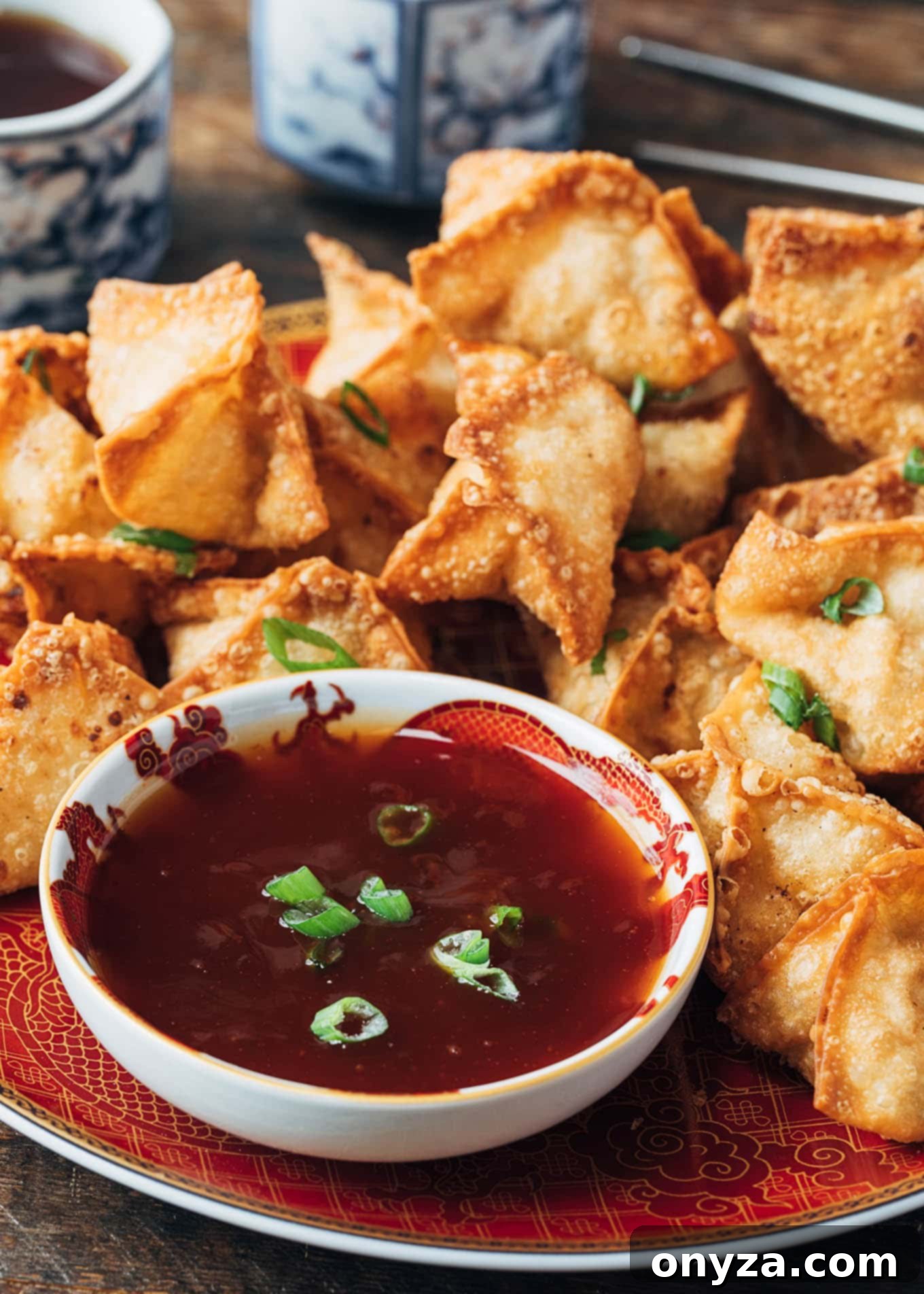Unlock the secrets to crafting the ultimate homemade Crab Rangoon with this comprehensive guide. This beloved Chinese-American appetizer, featuring crispy wonton skins embracing a rich and creamy crab filling, is perfect for a special takeout fakeout night, entertaining guests, or elevating your game day spread. Discover traditional deep-frying, air-frying, and oven-baking methods to achieve your desired crispness.
What is Crab Rangoon? Exploring this Iconic Chinese-American Appetizer
Often ranking among the most popular Chinese dishes in America, just behind favorites like General Tso’s Chicken, Crab Rangoon holds a special place in the hearts of many food enthusiasts. This distinctive appetizer consists of crispy fried wontons generously filled with a delectable blend of cream cheese and seasoned crabmeat. You might also encounter them under names like “crab puffs” or “cream cheese wontons,” although the latter can sometimes refer to variations without the crab.
Despite its widespread association with Chinese restaurants in the United States, Crab Rangoon is, in fact, **not an authentic dish from traditional Chinese cuisine.** Its origins are widely debated, adding to its intriguing culinary history. Many food historians and enthusiasts trace its inception to the original Trader Vic’s tiki restaurant in San Francisco, supposedly in the 1950s, a hub known for its exotic Polynesian-themed fare and cocktails. Other theories suggest a connection to the 1904 St. Louis World’s Fair, or even draw inspiration from British-controlled Burma in the early twentieth century. Regardless of its precise beginnings, Crab Rangoon has firmly established itself as a beloved staple of Chinese-American culinary culture, celebrated for its unique blend of textures and flavors.
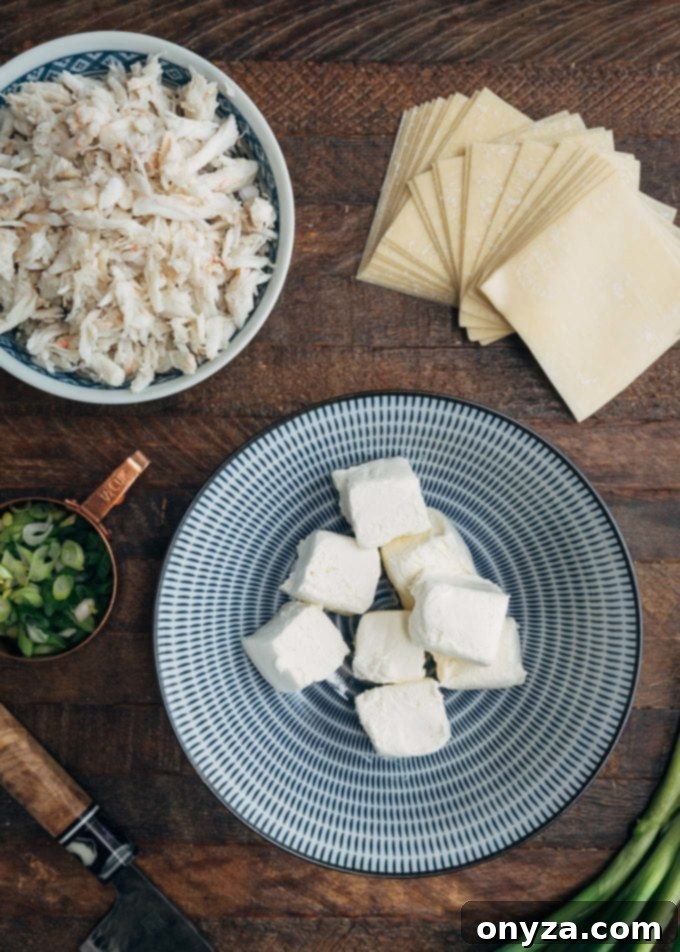
Crafting the Irresistible Crab Rangoon Filling at Home
Making Crab Rangoon at home is surprisingly straightforward, and the results far surpass most store-bought or even many restaurant versions. The creamy crab and cream cheese filling is quick to prepare, typically taking no more than five minutes. The most time-consuming part of the process is folding the individual wontons, which can be turned into a fun, collaborative activity for the whole family!
Over the years, after tasting countless Crab Rangoon variations from various establishments, I’ve encountered fillings that were either overly sweet, too runny, or simply lacked sufficient seasoning. My signature Crab Rangoon recipe focuses on achieving a perfectly balanced, richly flavored filling. It combines the tangy richness of cream cheese with a symphony of classic Asian-inspired seasonings: a touch of Chinese light soy sauce for savory depth, the fruity, umami-packed notes of Worcestershire sauce, fragrant sesame oil, and a delicate pinch of ground white pepper. This harmonious blend creates a filling that is subtly sweet, delightfully toasty, and perfectly complements the delicate flavor of the crab, garlic, and fresh scallions.
For those who enjoy a little kick, a simple customization can elevate your Crab Rangoon experience. Consider adding a small amount of Sriracha to the cream cheese mixture. Start with a quarter or half teaspoon and adjust to your preferred level of spiciness, transforming this classic into a thrilling new sensation.
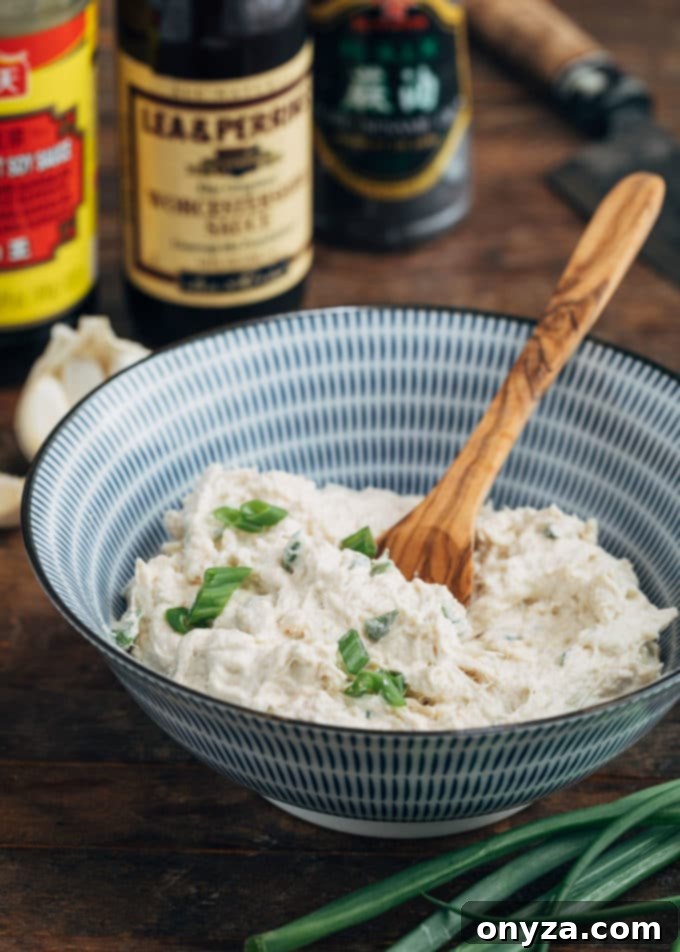
Selecting and Mastering Wonton Wrappers for Perfect Puffs
The choice of wonton wrappers significantly impacts the final texture and appearance of your Crab Rangoon. You can opt for either eggless (Shanghai-style) or egg-based wonton wrappers. The yellow-hued, **egg-based wrappers** tend to offer a richer flavor profile and **fry up to a more deeply golden color**, adding to their visual appeal and taste. Both types, however, will yield delicious results when prepared correctly.
When it comes to folding, you have several creative options, ranging from simple to more intricate designs. A **single-fold triangle** is the quickest and easiest method, perfect for beginners or when you’re short on time. For a more traditional or visually appealing presentation, you can try more elaborate folds like the elegant “purse” shape or a charming “star” design. My personal preference, often seen in local Chinese restaurants, involves folding the wrapper so all four corners meet in the middle, creating a neat, symmetrical puff as shown in the accompanying photos.
Regardless of the folding technique you choose, three crucial steps are paramount to ensuring successful and safe frying: **a.) avoid overfilling the wontons**, as too much filling can make sealing difficult and lead to ruptures; **b.) meticulously press out any air pockets around the filling** before sealing, as trapped air can cause the wontons to burst during cooking; and **c.) ensure that you seal the edges tightly and firmly.** Failing to properly seal the wontons increases the risk of them splitting open during frying, which can not only ruin your appetizer but also cause dangerous oil splatter if the hot filling is released into the oil. Keep your wrappers covered with a damp cloth while working to prevent them from drying out, which can make them brittle and harder to seal.
Choosing the Right Crabmeat: Real vs. Imitation
While many Chinese-American restaurants opt for imitation crabmeat in their Crab Rangoon due to cost and convenience, I strongly advocate for using **real crabmeat** (whether fresh or pasteurized) in this recipe. The superior flavor and texture of real crab truly elevate the dish, transforming it from a good appetizer into an extraordinary one. However, if imitation crab is your preference or all that’s available, you can certainly substitute finely-chopped imitation crab in this recipe; just be sure to adjust seasonings as imitation crab often has a sweeter, more processed flavor.
When selecting real crabmeat, there’s no need to splurge on expensive jumbo lump crab. Since the crabmeat is finely mixed with cream cheese to create a creamy filling, its individual texture isn’t as prominent. I typically use **lump crabmeat**, which offers a good balance of flavor and affordability. “Backfin” or “special” grades are also excellent choices and work perfectly for this application.
Crucially, regardless of the type of crabmeat you choose, always remember to **thoroughly drain it**, pressing out any excess liquid. This step prevents a watery filling. Furthermore, meticulously **pick over the crabmeat for any cartilage or shell fragments.** There’s nothing more disappointing than biting into an otherwise perfect, creamy Crab Rangoon only to encounter an unwelcome piece of cartilage.
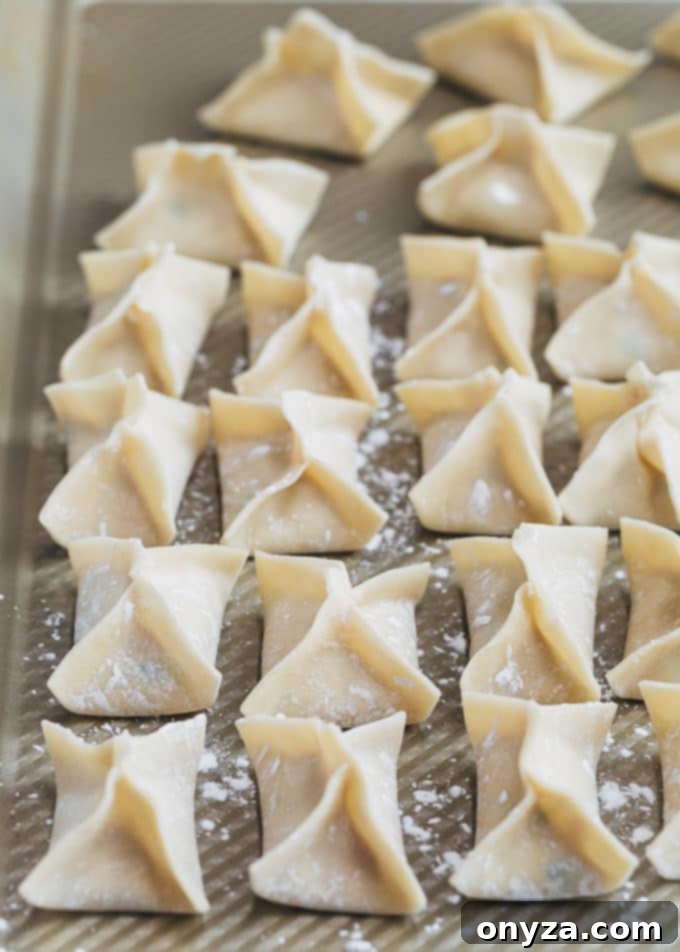
Achieving Crispy Perfection: Exploring Cooking Methods
For authentic, restaurant-style Crab Rangoon with their characteristic crispy, blistered wonton skins and uniformly golden color, **deep frying is undeniably the preferred cooking method.** No other technique can perfectly replicate that unique texture and rich, deep-fried flavor. However, if you’re looking for a lighter option without sacrificing too much flavor, you have excellent alternatives in the **oven or air fryer.**
Traditional Deep Frying
To deep fry, heat vegetable or peanut oil to a precise 350-360 degrees F in a large, deep pot. Frying in small batches (4-6 wontons at a time) is key to maintaining oil temperature and preventing overcrowding, which can lead to soggy wontons. Move them gently with a slotted spoon or spider strainer until they achieve a beautiful golden brown, typically within 3-4 minutes. Immediately transfer them to a paper-towel-lined plate to drain excess oil. The crispiness is best enjoyed soon after frying.
Lighter Alternatives: Oven Baking and Air Frying
While delicious, it’s important to manage expectations for oven-baked and air-fried Crab Rangoon. They will not have the exact same puffy, blistered, and uniformly golden texture as their deep-fried counterparts. The crunch will be different, but they offer a fantastic, lighter alternative.
- **To Bake:** Preheat your oven to 400 degrees F. Arrange the filled and folded wontons on a parchment-lined baking sheet, ensuring they are not touching. Lightly spray them with cooking spray for a touch of crispness. Bake for 8-12 minutes, or until they are golden brown and crispy to your liking.
- **To Air Fry:** Preheat your air fryer to 350 degrees F. Lightly spray both the air fryer basket and the wontons with cooking spray. Alternatively, you can brush the wontons lightly with oil. Air fry in a single layer in small batches for 8-10 minutes, shaking the basket gently halfway through to ensure even cooking and crispness. Keep in mind that air fryer models can vary significantly, so watch your first batch closely and adjust the cooking time as needed for your specific appliance.
Regardless of the method, freshly cooked Crab Rangoon are always best enjoyed warm.
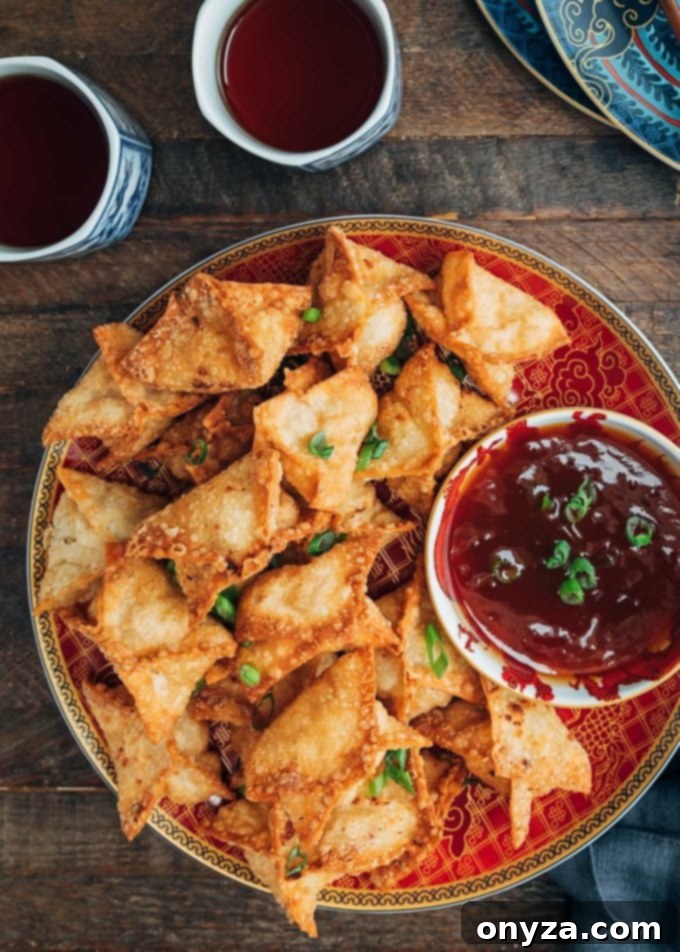
Perfect Pairings: Serving Your Homemade Crab Rangoon
After frying, allow your homemade Crab Rangoon to drain on paper towels for just a couple of minutes. This brief rest helps to cool the filling slightly and ensures they aren’t too hot to enjoy. While irresistible, Crab Rangoon are best served fresh and warm, as they tend to lose their crispiness the longer they sit. A quick 3-5 minute rest is all they need before being devoured.
A classic accompaniment, and a favorite at many Chinese restaurants, is **sweet and sour sauce.** It’s surprisingly simple to make at home and can even be prepared in advance. I’ve linked to a reliable recipe for homemade sweet and sour sauce within the recipe card below. Beyond this classic, Crab Rangoon also pairs wonderfully with other popular dipping sauces. I particularly enjoy them with rich **plum sauce** from an Asian market, the fruity tang of **duck sauce**, or the invigorating kick of Chinese-style **hot mustard**, much like how I’d serve my Fried Wonton Strips.
For entertaining, especially during a game day party or a casual gathering, setting out an array of small dipping bowls filled with various sauces allows guests to customize their experience and adds a fun, interactive element to your spread.
Crab Rangoon Recipe
Crispy wontons embrace a creamy crab filling in this highly popular Chinese-American appetizer. These homemade Crab Rangoon are simple to prepare and an excellent choice for entertaining!
Author: Amanda Biddle
Prep Time: 35 minutes
Cook Time: 25 minutes
Total Time: 1 hour
Servings: 12 servings (of 3 rangoon)
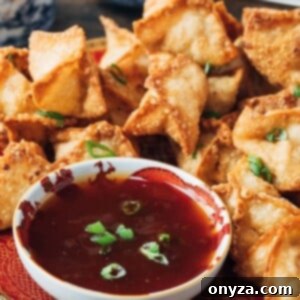
Ingredients
- 8 ounces block-style cream cheese, softened
- 6 ounces crabmeat (1 cup), picked over for cartilage and drained well
- 1 teaspoon toasted sesame oil
- 1 teaspoon light soy sauce
- 1-1/2 teaspoons Worcestershire sauce
- 1 clove garlic, minced
- ¼ cup thinly-sliced scallions
- pinch ground white pepper
- 36 wonton wrappers
- vegetable oil or peanut oil, for frying**
- sweet and sour sauce, duck sauce, plum sauce, or Chinese hot mustard, for dipping
Instructions
- In a medium bowl, stir together the softened cream cheese, sesame oil, soy sauce, Worcestershire sauce, and ground white pepper until well combined. Gently fold in the minced garlic, thinly-sliced scallions, and drained crabmeat until evenly distributed.
- Place approximately 1-1/2 teaspoons of the filling in the center of a wonton wrapper. Be careful not to overfill, as this can make sealing difficult. Lightly dampen the perimeter (edges) of the wrapper with water or an egg wash (made by beating 1 egg with 1 teaspoon of water).
- To form the classic shape: fold the bottom left corner of the wrapper up over the filling to meet the top right corner, forming a triangle. Then, fold the two remaining corners towards the center, creating a small wonton purse shape. Ensure you press out any air surrounding the filling and firmly press all the edges together to seal securely.*
- While working, keep the stack of unused wonton wrappers and the already folded wontons covered with a lightly-dampened towel. This prevents them from drying out, which can cause cracking.
- For deep frying: Heat vegetable oil or peanut oil** in a large, deep pot to 350-360 degrees F. Fry the wontons in small batches (4-6 at a time), ensuring you do not overcrowd the pan. Gently move them around with a slotted spoon or a spider strainer and fry until they are uniformly golden brown and crispy, typically 3-4 minutes.
- Remove the fried wontons to a paper-towel-lined plate to drain any excess oil. Serve immediately with your favorite dipping sauce, such as sweet and sour sauce (recipe linked above), duck sauce, plum sauce, or hot mustard.
Notes
- *Proper sealing of the wontons and the removal of air pockets are essential for safety. Wontons that split during deep frying can cause dangerous oil splatter.
- **If using peanut oil for frying, please be aware of potential allergens. I always like to inform guests when I’ve used peanut oil.
To Bake:
Preheat oven to 400 degrees F. Place filled and folded wontons on a parchment-lined baking sheet and spray them with cooking spray. Bake for 8-12 minutes, until golden.
To Airfry:
Preheat airfryer to 350 degrees F. Lightly spray both the airfryer basket and the wontons with cooking spray. (You can also brush the wontons with oil.) Airfry in small batches (single layer) for 8-10 minutes, until crispy, gently shaking the basket halfway through. (Airfryer models can vary significantly in terms of cooking times. Watch the first batch closely and adjust the time for your specific model.)
Note that baked or air-fried wontons will not be as puffy and blistered or uniformly golden as those that have been deep fried. The texture is different, but they’re a delicious, lighter alternative!
Nutrition Estimate (per serving)
Calories: 164kcal | Carbohydrates: 14g | Protein: 7g | Fat: 8g | Saturated Fat: 6g | Cholesterol: 10mg | Sodium: 418mg | Potassium: 115mg | Sugar: 1g | Vitamin A: 40IU | Vitamin C: 1.7mg | Calcium: 87mg | Iron: 1mg
Nutrition information is automatically calculated, so should only be used as an approximation.
Please note that our recipes have been developed using the US Customary measurement system and have not been tested for high altitude/elevation cooking and baking.
